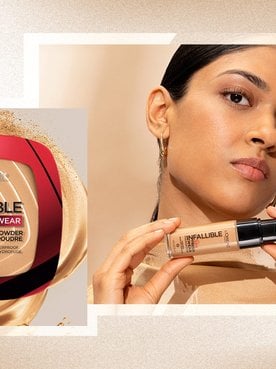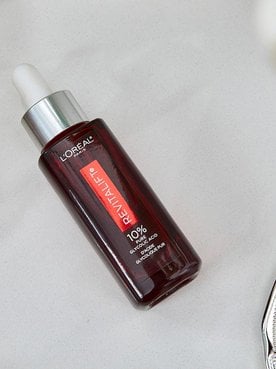Before coloring your hair, there are a few things you should do. You’ll want to stock up on color-safe products designed to protect your hue, of course, and maybe look into heatless hairstyles you can turn to when your strands need a break. But it’s also important to know how to remove hair dye in case things go awry—or you’re simply ready for a change.
While removing hair dye isn’t as straightforward as applying color, it is possible—and you don’t necessarily need to hit the salon to make it happen. Below, learn how to use hair color remover to help fade unwanted color and get back to your roots without unnecessary damage.
Shop the Products
Does Removing Hair Dye at Home Work?
Removing hair dye at home can work, but success depends on the type of dye. Semi-permanent and temporary formulas sit on the hair’s surface, so they’re typically easier to fade, making it simpler to remove semi-permanent hair color. Permanent dyes place pigment inside the hair’s inner cortex—great for longevity, but harder to remove permanent hair dye.
If you’re wondering how to remove hair dye safely, start with the right hair color remover and approach. You can often improve or correct unwanted tone at home, while deeper corrections are best handled by a pro.
How To Strip Hair Color
What you use to remove hair color depends on the dye category (temporary, semi/demi, or permanent), how recently you colored, and your hair’s current condition and end goal. Before choosing an approach, assess porosity, scalp sensitivity, and how far you need to shift—these factors will determine how to remove hair dye (and how long it takes) and whether it’s realistic to remove hair color at home or plan a pro correction.
How to remove semi-permanent hair color
To remove semi-permanent hair color, you can start with the least‑aggressive options: clarifying or chelating shampoo, a hair color remover, and time—these approaches help strip hair color from the surface gradually. Always strand‑test first and moisturize between steps.
Use an at-home hair dye remover
An at-home hair dye remover can reduce artificial pigment in semi-permanent color. It won’t restore hair to its exact virgin shade; instead, it evens the canvas for predictable re-coloring. If your goal is to return close to natural, strip with remover, then re-color with L’Oréal Paris Excellence Crème Permanent Triple Care Hair Color to help protect hair before, during, and after coloring. Choose from 30 shades and pick the one closest to your natural color for an easier grow-out.
Consider letting the hair dye fade on its own
Semi-permanent color typically lasts several weeks—about six to eight washes—and fades gradually. If you can, let it fade naturally to avoid additional processing. Washing more frequently can speed fading; balance with moisture care to prevent dryness.
Use a clarifying shampoo

When you lather up, reach for a clarifier such as L’Oréal Paris EverPure Sulfate-Free Clarifying Shampoo with Antioxidants. Deep-cleansing formulas help lift buildup and may assist color fade.
Follow with L’Oréal Paris EverPure Sulfate-Free Restoring Conditioner with Antioxidants to replenish moisture after washing.

Shop the Products
How to remove permanent hair dye
To remove permanent hair dye, plan on color reduction and/or a professional correction. Stubborn shades (like black and vivid reds) may take multiple sessions. If hair was bleached, there’s no pigment to lift—you’ll tone or recolor instead.
Go to the salon
Removing permanent color is typically a salon service. A professional colorist can reduce artificial pigment with minimal damage and fix issues like orange bands. If you’re worried about breakage, ask for a strand test first—they’ll test a small section (often at the nape) before proceeding.
Consider the color you used
Some shades are more stubborn than others. Permanent black hair dye is notoriously difficult to fully remove (a pro may lighten it gradually). And bleach can’t be “removed” at all—there’s no pigment to lift—though you can color over bleached hair with the right shade and care.
Hair Type Considerations
Your hair’s type and condition influence results. In general, thicker, coarser hair tolerates stronger removers better than fine, fragile hair or sensitive scalps. Start conservatively and prep with strengthening care. We like the L’Oréal Paris EverPure Sulfate Free Bond Repair Shampoo with Citric Acid and the EverPure Sulfate Free Bond Repair Conditioner with Citric Acid to help reinforce weak, brittle strands before and after any color-removal steps.

Shop the Products
How Long Does It Take to Remove Hair Dye?
How long it takes to remove hair dye depends on the dye. Hair gloss and semi- or demi-permanent color often fade over 4–12 washes, making them faster to remove. Temporary root touch-ups and color sprays wash out with shampoo. Permanent hair dye can require multiple sessions to fade; black and red dyes are especially persistent. In some cases, an alternative approach—blending regrowth with a root touch‑up, strategically re‑coloring closer to your natural range, or opting for a shape‑refreshing cut—is the smarter route.
3 Additional Ways To Get Back to Your Natural Hair Color
If you're not ready for another round of remover, these low‑stress options can help you get back to your natural hair color with less processing. Choose the path that fits your timeline and pair with bond‑repairing, color‑safe care to keep strands strong as you remove hair color gradually.
1. Grow out your hair
It’s the least damaging route—just the slowest. If a harsh line of demarcation bothers you, use L’Oréal Paris Magic Root Cover Up to blur roots until your next trim.
2. Dye your hair—again
For a quick visual reset, re-color to a shade close to your natural. You’ll essentially be “faking it” while your natural color grows in. L’Oréal Paris Excellence Crème Universal Nudes offers rich, natural-looking results in a gentle formula, helping blend dyed lengths with regrowth. For dramatic changes (e.g., dark brown to red), see a professional colorist for guidance.

Shop the Products
3. Opt for a short hairstyle
If you're feeling impatient, a chic chop reduces the amount of dyed length you need to grow out. From buzz cuts to pixies, once the colored ends are gone, your new growth is a blank slate.
Common Mistakes to Avoid When Removing Hair Color
Even with the right plan, color correction can veer off track fast. Read these common missteps first so you can pace treatments, choose the appropriate hair color remover, and build in bond‑repairing aftercare—especially if your goal is to remove hair color at home with minimal damage.
- Never use bleach without experience: Bleach is powerful and permanent—misuse can cause uneven lift, banding, and breakage. When in doubt, book a pro.
- Don't mix multiple removal methods too soon: Stacking treatments (remover → bleach → dye in one day) stresses the cuticle. Space services and reassess after each step.
- Don't skip strand tests: A strand test shows how your hair reacts, so you can calibrate processing time and expectations.
- Never skip aftercare and hydration: Post-removal hair craves repair. Work in weekly treatments like L’Oréal Paris Elvive Total Repair 5 Power Restore Multi-Use Treatment for stronger, healthier-looking hair.
FAQs: Removing Hair Color at Home
How can I remove hair dye from my hair at home?
To remove hair dye from your hair at home, use a hair color remover for semi‑permanent shades, pair it with clarifying shampoo, and give it time; for permanent color, consult a pro since at‑home success is limited and the damage risk is higher.
What is the fastest way to remove hair color?
The fastest way to remove hair color is a salon‑performed remover or color‑correction service. At home, clarifying washes plus an at‑home remover can speed fade for semi‑permanent dyes, but always be mindful about stacking treatments to avoid extra damage.
What removes permanent hair color?
Permanent hair color is removed with color‑reduction (hair color remover) and/or professional lightening. Shampooing alone won’t fully remove permanent pigment.
What is the hardest hair color to remove?
The hardest hair colors to remove are black and vivid reds due to pigment load and stain potential. Expect multiple sessions and plan for robust aftercare.
Does clarifying shampoo remove hair dye?
Clarifying shampoo can help remove hair dye by aiding in the removal of fade-through residue and buildup. Pair with a restoring conditioner or mask to maintain softness.
Should I use bleach to remove hair dye?
You should not use bleach to remove hair dye at home; bleach is a professional service. Improper use can cause damage and uneven results—always strand‑test and consult a colorist.
Next Up: Which L’Oréal Shampoo Is Right for Your Hair?
Photo courtesy of L’Oréal Paris







